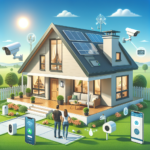In today’s world, managing energy consumption is crucial not just for the environment but also for household budgets. Smart home technology offers an innovative way to monitor and reduce energy use, translating to significant savings on your energy bills.
What is Smart Home Technology?
Smart home technology encompasses a variety of devices and systems that can be controlled remotely via the internet. These devices include smart thermostats, lighting systems, plugs, and appliances that work together to optimize energy consumption.
Types of Smart Home Technology for Energy Savings
- Smart Thermostats: These devices learn your schedule and adjust the temperature accordingly, reducing energy use when you are not home.
- Smart Lighting: Automatic adjustments based on occupancy and natural light can cut down on electricity usage.
- Smart Plugs: Monitor and control the power used by plugged-in devices, making it easier to eliminate standby power consumption.
- Energy Monitoring Systems: Provide real-time data on energy consumption, allowing you to identify areas for improvement.
Installation and Setup
Setting up smart home technology is easier than you might think. Most smart devices come with user-friendly apps that guide you through the installation process. It is advisable to follow manufacturer instructions closely to ensure optimal performance and energy savings.
Benefits of Using Smart Home Technology
- Cost Savings: Automating energy use leads to more efficient consumption, which can significantly lower your energy bills.
- Convenience: Remote control and automation offer unparalleled convenience in managing your home’s energy use.
- Environmental Impact: Lower energy consumption means reduced carbon footprint, contributing positively to environmental conservation.
- Enhanced Security: Many smart devices also offer security features, such as remote monitoring and automated lighting, that make your home safer.
Pro Tips for Maximizing Savings
To fully benefit from smart home technology, consider the following tips:
- Regularly update your smart devices to the latest firmware to ensure they run efficiently.
- Utilize scheduling features to automate energy savings during peak and off-peak hours.
- Integrate devices to create a cohesive system; for instance, combining smart thermostats and smart lighting can compound savings.
- Monitor energy reports from your smart devices to identify and address high-consumption areas.
By incorporating smart home technology, you’ll find that saving on energy bills becomes simpler and more efficient. Whether you start with a single device or fully automate your home, the benefits in cost, convenience, and environmental impact are substantial and long-lasting.


